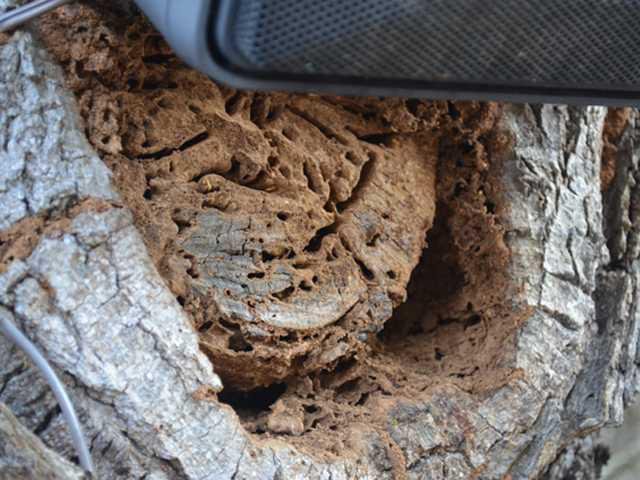A rare species of termites reported on in the Courier a year ago continued to spread through the building in which they were found, and now they’ve been discovered in the oak trees in Bradwell Park.
Roger Hutchinson, general manager for Yates-Astro in Hinesville, said that after his crew treated the offices of Arnold, Stafford and Randolph Law Firm at the intersection of M.L. King Jr. Drive and Main Street, they ended up treating all the offices in that building. He said Formosan termites now have been found in the two large oak trees outside the building in Bradwell Park.
“We don’t know if these oak trees are the source, but we do know they’re here, and they need to be treated,” Hutchinson said. “We’ve had University of Georgia entomologist Dr. Brian Forschler here to help us, as well as Hinesville arborist Jerry Holcomb.”
Wednesday morning, Hutchinson, his crew and Holcomb began working on the big oak closest to the previously infested building. While crew members Dale Hutchinson and Chuck Thompson inspected the tree from a forklift, Hutchinson inspected examined infestation spots from a ladder, and Holcomb drilled into the side of the tree at different levels to see if he could find a cavity.
Hutchinson said they found several obvious areas where the termites had bored into the tree, including a large cavity at a fork between two thick limbs. He said they filled that cavity with 50 gallons of a topical pesticide.
“That was just one of several places on that tree,” he said, pointing to close-up photographs he had taken of the damaged tree. “Several knotholes show signs of infestation and here’s evidence of tunneling they’re making down the side of the tree.”
A year ago, Hutchinson explained that the Formosan termite is more aggressive than eastern subterranean termites. Part of the problem with a Formosan infestation is that this species not only attacks trees and wood structures from below the earth, but also from the air. He said they’ve become a severe problem in Louisiana, where trees and telephone poles are being destroyed.
Normal “swarm season” for termites is February to May, but Hutchinson said Formosan terminates swarm during May and June. A Formosan termite colony also tends to be four to five times larger than a normal colony of termites, giving it the potential to cause even more damage to property.
Hutchinson again reminded local residents to watch out for signs of termite damage in their homes, businesses or trees. These signs include wood dust or shavings, and discarded wings or mud mounds clinging to the walls, windows and door frames or baseboards. Anyone who suspects termites are in their home or business should call a professional exterminator, he said.
He said Forschler is scheduled to talk about Formosan termites and other pests at the Liberty County Chamber of Commerce’s next “Eggs and Issues” breakfast July 22.
Rare termite finds home in Hinesville
Downtown office, park have been infested


Sign up for our e-newsletters